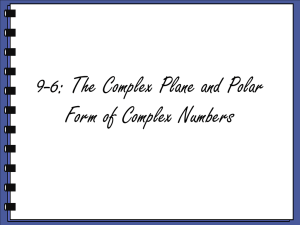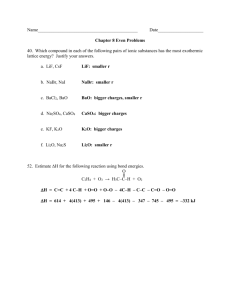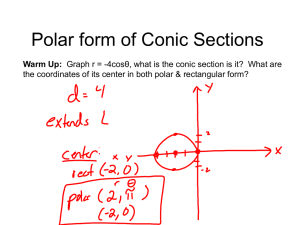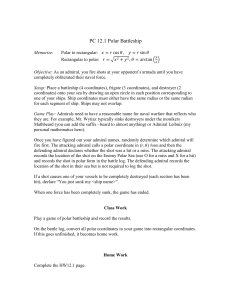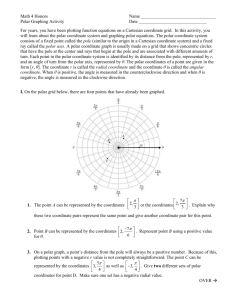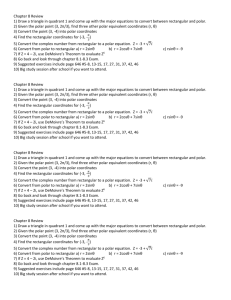Math 144 Activity #12 Polar Coordinates Defining functions in two
advertisement
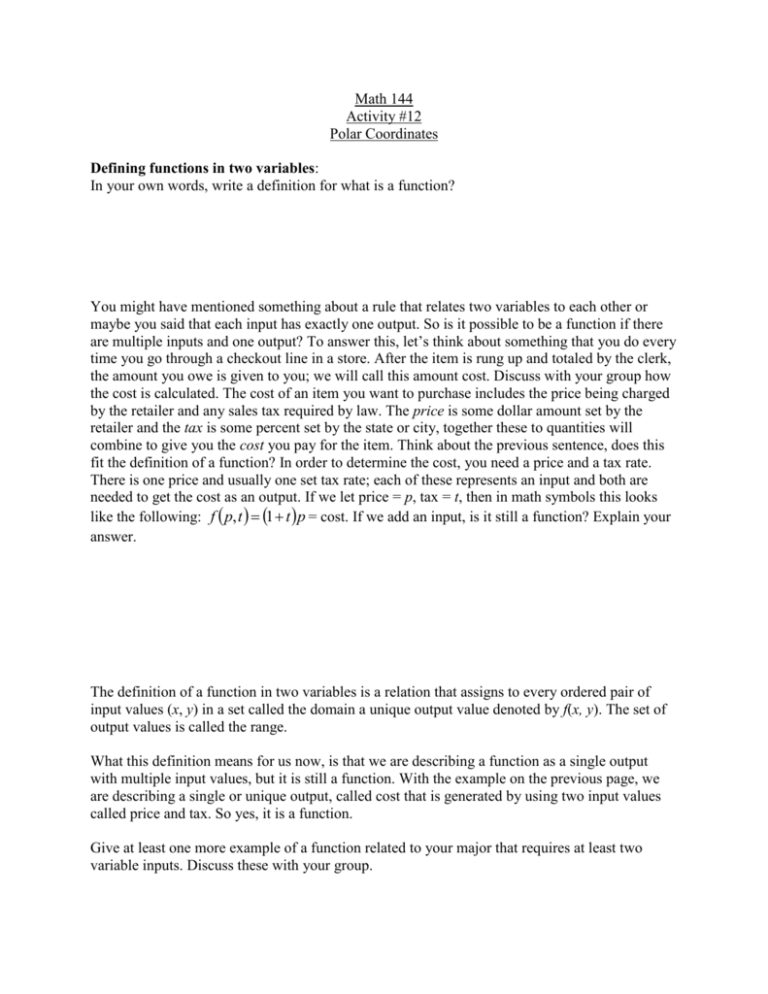
Math 144 Activity #12 Polar Coordinates Defining functions in two variables: In your own words, write a definition for what is a function? You might have mentioned something about a rule that relates two variables to each other or maybe you said that each input has exactly one output. So is it possible to be a function if there are multiple inputs and one output? To answer this, let’s think about something that you do every time you go through a checkout line in a store. After the item is rung up and totaled by the clerk, the amount you owe is given to you; we will call this amount cost. Discuss with your group how the cost is calculated. The cost of an item you want to purchase includes the price being charged by the retailer and any sales tax required by law. The price is some dollar amount set by the retailer and the tax is some percent set by the state or city, together these to quantities will combine to give you the cost you pay for the item. Think about the previous sentence, does this fit the definition of a function? In order to determine the cost, you need a price and a tax rate. There is one price and usually one set tax rate; each of these represents an input and both are needed to get the cost as an output. If we let price = p, tax = t, then in math symbols this looks like the following: f p, t 1 t p = cost. If we add an input, is it still a function? Explain your answer. The definition of a function in two variables is a relation that assigns to every ordered pair of input values (x, y) in a set called the domain a unique output value denoted by f(x, y). The set of output values is called the range. What this definition means for us now, is that we are describing a function as a single output with multiple input values, but it is still a function. With the example on the previous page, we are describing a single or unique output, called cost that is generated by using two input values called price and tax. So yes, it is a function. Give at least one more example of a function related to your major that requires at least two variable inputs. Discuss these with your group. Polar functions: The graphs of polar functions are quite fascinating. Below you can see a few examples of such graphs along with the equation that makes the graph and their name. Equation: r 2 2 cos This graph is called a cardioid. It can be rotated half pie in any direction in the polar plane. Equation: r 3 cos( 2 ) This graph is called a rose. The number of pedals will vary as you change the multiplier on theta. Equation: r 4 sin( ) This graph is of course a circle. These are the graphs of functions. They are polar functions and if we were to convert them to rectangular coordinates, they would not be functions. Extension Question: Convert the equation r 4 sin( ) to rectangular by using the relationships that you found last week. Graphing Polar Functions with a calculator: We want to be able to produce these graphs, but to do this by hand can be very time consuming and with the advancement of technology these graphs can be drawn quickly in a matter of seconds. Recall these are polar functions, which are not the same the functions y = f(x) you are familiar with. In order to graph these functions, you must change the settings in your calculator. Press the mode button on your calculator; there you will find a list of various settings. Find in the list where it says function or func, from there, you want to select polar. To do this, move the cursor to pol or polar in the function list and press enter. With the polar function selected, press the Y= button. What do you notice? You should see a list of r = ‘s instead of y =’s. This is because polar functions require a distance, r, and an angle, . Click on the window button, what do you see? Be sure to scroll down to see the entire list. Each item in the list is important and you need to be careful setting these values. The first three values set the angle ; min is the smallest value you want to be, max is the largest value you want to be and step is how often you want you calculator to evaluate the function. The last six values are just as they would be in the function mode (xmin is the smallest x value and yscl is the scale of the y axis, etc). Let’s explore what value you should be using for step, but first what are the different units of measure that can be used for angle measures? It does not matter which unit you use when graphing, but you must have consistency in the mode setting and the values used in the window. If you let min = 0 and max = 360, what mode should your calculator be in? Explain. Change the values in the window to match the values above; use xmin= –5, xmax=5, xscl=1, ymin= –5, ymax=5, and yscl=1, then use each of the values below for step and describe what you see when graph the function r 2 2 cos . step = 90 step = 45 step = 30 step = 15 step = 1 What did you notice about the shape of the graph as you changed the step value? What did you notice about the speed at which it graphed each time you changed the step value? What value should you choose for your step and why? Now let’s adjust max to see if it needs to be considered at any time. Change the values in the window to match the values above; use min= 0, step= 5, min= –5, xmax=5, xscl=1, ymin= –5, ymax=5, and yscl=1, then use each of the values below for max 1 and describe what you see when graph the function r 3 cos . Also draw the graph for 4 each. max = 360 max = 720 max =1080 max = 1440 max = 1800 Discuss with your group what the graph of x = 2 looks like the rectangular coordinate (xy-plane) system. Draw the graph below. y Will your calculator draw this graph in the xy-plane? Explain. x If you answered yes to the question above, go back and ask for help. Let’s see if you can get your calculator graph it in the polar mode. To do this, you need to convert the rectangular coordinate of x to polar coordinates r and . What expression is x equivalent to in polar coordinates from the last activity? Replace x with that expression and then solve your resulting equation for r. You should have a polar function in the form r f or r 2 / cos . How does this graph compare to the graph above that you drew? Sketch each of the polar functions below. Make sure you set an appropriate window for each. a. r 3 sin 2 b. r 2 3 cos

